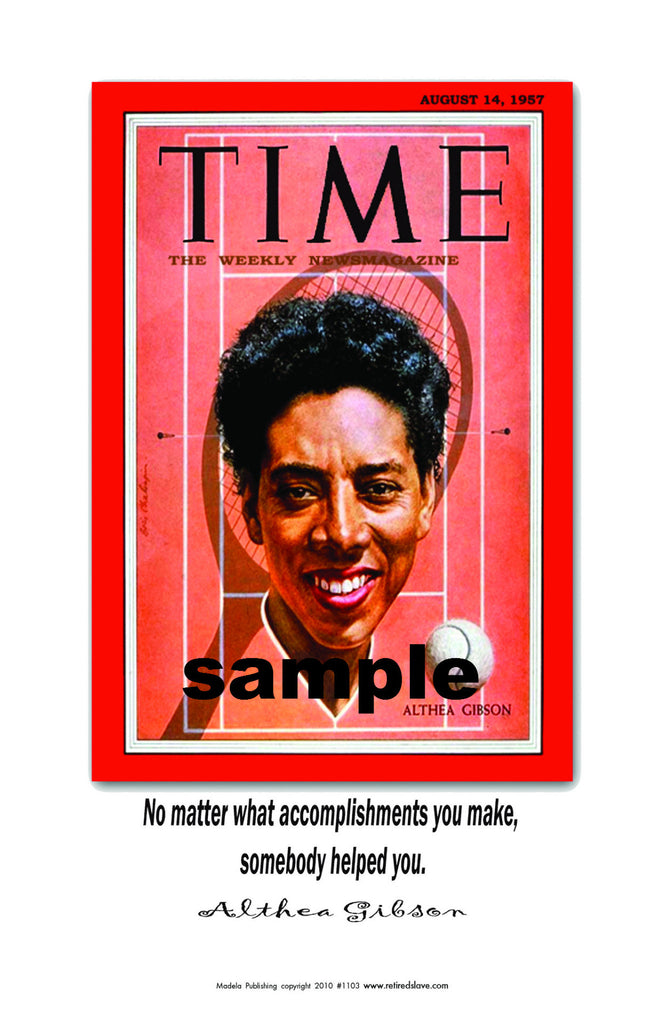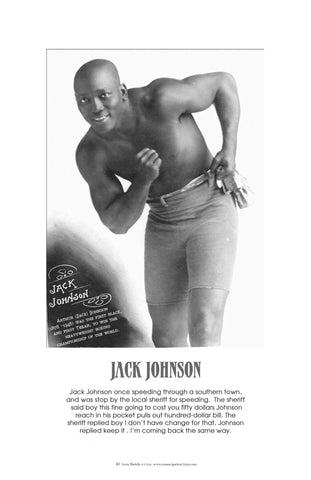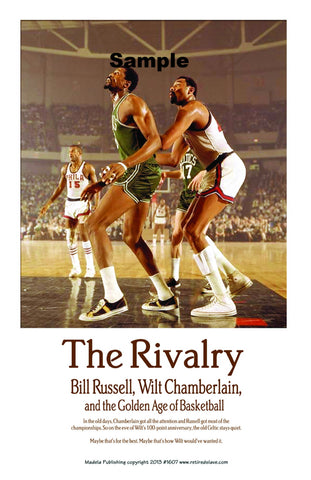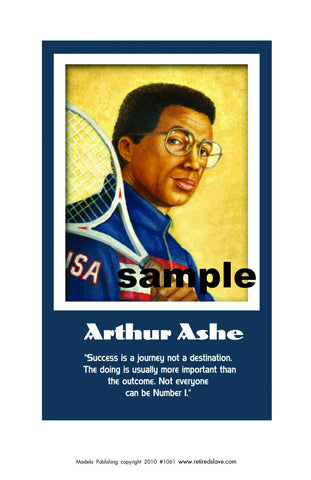Althea Gibson #1103
$ 10.00
Caption from poster__
" No matter what accomplishments
you make, somebody helped you."
Althea Gibson
Before Althea Gibson could play -- much less win -- major tennis tournaments, another opponent had to be defeated. But Gibson had less control against this foe, which went by the name segregationJackie Robinson played in the major leagues (1947) before a black was permitted to play tennis at the U.S. National Championships.But cracks soon developed in the lily-white sport. And finally, in 1950, when Gibson was 23 years old, she was permitted to play at the U.S. Nationals, becoming the first black to compete in the tournament. She also later cracked the color barrier at Wimbledon.
In 1956, Gibson made history by becoming the first black person to win the French championships. The next year, she made more history by winning Wimbledon and the U.S. Nationals, the first black to win either. She must have liked winning the world's two most prestigious tournaments, too, because she repeated the accomplishments in 1958.
The 5-foot-11 right-hander had a strong serve and preferred to play an attacking game. An athletic woman, she had good foot speed, which allowed her to cover the court. As the years went on, she became more consistent from the baseline. Including six doubles titles, she won a total of 11 Grand Slam events on her way to the International Tennis Hall of Fame and the International Women's Sports Hall of Fame.
Gibson was born Aug. 25, 1927, in the small town of Silver, S.C. The family moved to Harlem in New York City when she was 3. Growing up there, Gibson disliked going to school so much that she often played hooky.
"Daddy would whip me," she said, "and I'm not talking about spankings." But she didn't blame her father for the whippings, saying she deserved them. Aside from an occasional fight, she was never in any real trouble.
What Gibson liked to do was play sports, At first, basketball was her favorite. Next she became quite proficient in paddle tennis. Then a friendly musician gave her a tennis racket, and she immediately took to the game.
She quit high school -- not because of tennis but because she couldn't stand classes -- and began competing in girls tournaments under the auspices of the American Tennis Association, which was almost all black. In 1946, she attracted the attention of two tennis playing doctors, Hubert Eaton of North Carolina and Robert W. Johnson of Virginia, who were active in the black tennis community.
Soon-to-be welterweight champion Sugar Ray Robinson and his wife, who had befriended Gibson, advised her to go South. She did. Each doctor took her into his family --
Eaton during the school year, Johnson in the summer. Not only did they provide tennis instruction, they also straightened her out academically. She went back to high school
for her last three years and graduated in 1949 in Wilmington, N.C. As the two-time winner of the national black women's tennis championship, Gibson thought she had a good case for being admitted to the 1950 U.S. Nationals. But it appeared as if she were going to be shut out again until Alice Marble, a four-time winner of the event, advanced her caused in the July 1950 issue of "American Lawn Tennis" magazine.
"If Althea Gibson represents a challenge to the present crop of players, then it's only fair that they meet this challenge on the courts," Marble wrote.
Finally, the U.S. Lawn Tennis Association relinquished and invited her. In her historic debut at the 1950 U.S. Nationals, Gibson defeated Barbara Knapp in straight sets. Her second-round match on the grass of Forest Hills was against Louise Brough, who had won the previous three Wimbledons. After being routed 6-1 in the first set, Gibson recovered to win the second set 6-3 and led 7-6 in the third when a thunderstorm struck, halting the match. When it resumed the next day, Gibson dropped three straight games to lose the match.
It took Gibson a while to adjust to the stronger competition. She also remained unwelcome at some clubs where tournaments were held. She was ranked No. 9 among American women in 1952, but it wasn't until four years later that Gibson displayed the game of a player ready to move into the first echelon.
She won her first major in 1956, the French championships, defeating defending champion Angela Mortimer 6-0, 12-10 on the clay courts in Paris. This was her only appearance at the French. She teamed with Englishwoman Angela Buxton to win the women's doubles title at the French, as well as at Wimbledon. That year she also won singles tournaments at the Italian, the Pacific Southwest, New South Wales, Pan American, South Australian and the Asian title in Ceylon.
The No. 2 seed at the U.S. Nationals, Gibson reached the final. Her opponent was top seed Shirley Fry, who played a steadier match and gained the championship with a 6-3, 6-4 decision.
In 1957, Gibson gained control of the women's game. First, she beat Darlene Hard 6-3, 6-2 to win Wimbledon. Then on Sept. 8, she made history in her own country, defeating Brough by the same score for the U.S. Championship. She also was part of the winning women's doubles team with Hard at Wimbledon and took the mixed doubles title with Kurt Nielsen at Forest Hills.
Even while winning tournaments she was denied rooms at hotels. One refused to book reservations for a luncheon in her honor. She said she didn't care. "I tried to feel responsibilities to Negroes, but that was a burden on my shoulders," she said in 1957. "Now I'm playing tennis to please me, not them."
She pleased herself -- and blacks -- in 1958 by defeating Mortimer 8-6, 6-2 in the Wimbledon final and rallying to beat Hard 3-6, 6-1, 6-2 for the U.S. title. Her third consecutive Wimbledon women's doubles title also was won, this time with Maria Bueno.
Her singles record at the Grand Slams events was an impressive 53-9 -- 16-1 at Wimbledon, 27-7 at the U.S., 6-0 at the French and 4-1 at the Australian.
As a member of the 1957 and 1958 U.S. Wightman Cup teams, she went 5-1 -- 3-1 in singles and 2-0 in doubles -- against Britain.
In 1957, she was the first black to be voted by the Associated Press as its Female Athlete of the Year. She won the honor again in 1958.
After winning her second U.S. Championship, she turned professional. One year she earned a reported $100,000 in conjunction with playing a series of matches before Harlem Globetrotter basketball games.
There was no professional tennis tour in those days. Gibson turned to the pro golf tour for a few years, but she didn't distinguish herself. She tried playing a few events after open tennis started in 1968, but by then she was in her 40s and too old to beat her younger opponents. She worked as a tennis teaching pro after she stopped competing.
Gibson has turned into a recluse in her well-kept garden apartment in East Orange, N.J., according to Time last September. The magazine said she is suffering in silence from a series of strokes and ailments brought on by a disease she is simply said to have described as "terminal."
The title of her autobiography, written in 1958, is "I Always Wanted to Be Somebody." To tennis fans, she always will be. Though she didn't go looking for the role of pioneer, she was one.
"If it hadn't been for her," says Billie Jean King, winner of 12 Grand Slam singles titles, "it wouldn't have been so easy for Arthur (Ashe) or the ones who followed."
Now available 11" x 17"
Print with Black Frames $25.00
For 24" x 36' Size prints
please call 678-608-7892 to order




